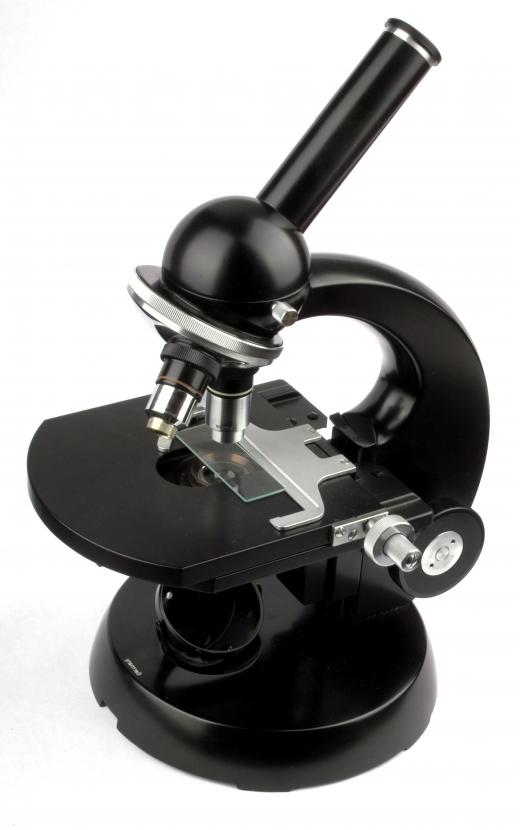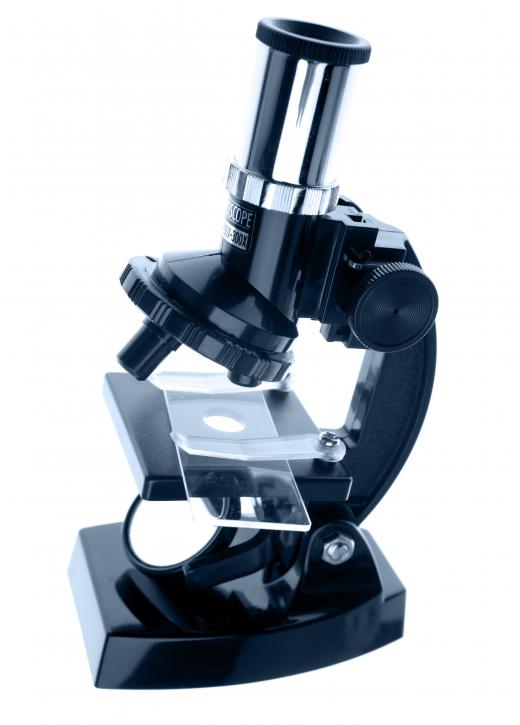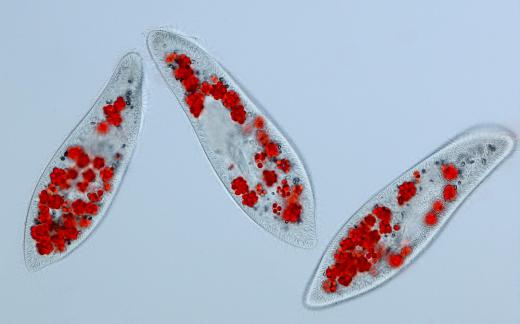What is a Monocular Microscope?
 Mary Elizabeth
Mary Elizabeth
A microscope is an instrument that produces an accurately enlarged image of small objects so that the user can see things on a larger scale. The word microscope comes from the New Latin word microscopium, which comes from the the combining form micr-, meaning “small” and scope, meaning “an instrument for viewing.” The word monocular is from Late Latin monoculus, which means “having one eye.” Thus, a monocular microscope is an instrument for viewing small things through a single lens.
Microscopes are classed both by the number of eyepieces, as well as by the way in which the image is enlarged. While a monocular microscope is made for one eye, binocular and stereo microscopes are made for both eyes. Trinocular microscopes are binocular or stereomicroscopes with a third eyepiece, which may either be for a second person to share the view or in order to affix a digital camera or video camera to the third eyepiece in order to create a lasting record of what was seen.

A monocular microscope can have single or compound lenses. Simple microscopes—those with a single lens—are only available as monocular microscopes. Single lens monocular microscopes include the various types of lenses that are also known as magnifying glasses. Also included are jeweler’s lenses or loupes, and reading glasses. Many people are not used to thinking of these as microscopes, but that is how they are classified.
Since various types of image distortion occur with a single lens, their uses are limited. One type is chromatic aberration, which distorts color. Another is spherical aberration with distorts the focus.

A compound lens magnifier is different from a compound microscope. A compound lens magnifier is one single array of simple lenses with a common access. The use of a compound lens is attractive because it can correct some of the single lens aberrations, as well as magnify at a higher power, and being handheld, it has the same flexibility as a magnifying glass or loupe. It is, by nature, a monocular microscope.

Although a compound microscope has a minimum of two lens arrays, which helps to increase the maximum magnification possible, it can still be a monocular microscope if it only has one eyepiece. One of the arrays is the ocular, and this is the lens array that the viewer looks through. The other lens array is the objective, which is positioned near the object that is being viewed.
AS FEATURED ON:
AS FEATURED ON:














Discussion Comments
@Charred - Yeah, I saw a program on amazing inventions and they also talked about another kind of microscope, the fluorescent microscope.
It basically works by beaming some fluorescent light at a sample, and then a weaker fluorescent light is reflected back.
Then a filter separates the two lights and creates the resulting image. It was pretty impressive and they showed how they used it to study things like blood samples for example.
@hamje32 - There are different microscope types depending on what you want to do; each of course come with varying degrees of magnification.
In industrial applications, I understand that they use what’s called a phase contrast microscope. My friend works in waste management and he tells me that they use this kind of microscope to examine hard to see things like specimens in sludge deposits.
It comes with a Halogen lamp and a Leica lens-one of the best lenses in the industry-to provide super sharp detail of images that would normally be impossible to see with a consumer grade lens.
Of course these microscopes are expensive, and more suited for labs and research facilities than anything else. I don’t think you need them to look at the plants in your backyard.
@David09 - That’s an impressive range for microscope magnification. It amazes me how two pieces of glass (assuming you’re using a compound microscope) can bend light in such a way as to create incredible details of magnification.
I think with the electron microscope, there is almost no limit to the magnification levels achieved. I once heard a scientist say that it might even be possible to see atoms themselves, the very building blocks of the universe, using an electron microscope.
My daughter invested in a student microscope when taking one of several courses on plant biology in college. It’s a monocular microscope that provides 400 times magnification, and also has a USB wire hookup so that she can transmit the images to a computer.
I guess it’s an electronic monocular microscope-she decided upon this extra functionality because she wanted to keep the images on her computer and use them in her reports. Even after she completed her courses she kept the unit and has been having a lot of fun continuing to look at plant and insect life in our backyard.
Of course, she’s planning to pursue this as a career, but even I found it fun to use. You see so much detail in the world around you and it just opens your eyes to how much of your immediate environment is just teeming with life at every level.
Post your comments